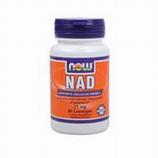
 Regular Retail: $21.99
Regular Retail: $21.99Other Ingredients: Maltodextrin, Sorbitol, Citric Acid, Cellulose, Natural Lemon-Lime Flavors and Magnesium Stearate (vegetable source). Vegetarian Formula.
Free of: salt, yeast, wheat, gluten, soy, milk or egg. No artificial flavors or colors are added to this product.
Caution: Do not eat freshness packet. Keep in bottle.
NAD (Coenzyme B-3) FAQ's
What is NAD or NAD(H)?
NAD is the abbreviation used for Nicotinamide Adenine Dinucleotide, the biologically active coenzyme form of vitamin B3 (Niacinamide). NAD is the oxidized form of coenzyme B3 that acts as a hydrogen (H) acceptor, while NAD(H) (known as NADH) is the reduced form that donates hydrogen as part of the Krebs’ Citric Acid Cycle (KCAC) and Electron Transport Side Chain (ETSC). NADH is a complex molecule comprised of vitamin B3, ribose, a mineral compound called a phosphate group and another compound called adenine nucleotide that can be made in the liver and other cells.
NAD and NADH can each be converted back-and-forth into the other form many times during the body’s energy production cycles. They are both involved in transferring electron pairs (energy “sparks”) during energy transfer reactions within the cell. Chemical energy in the form of ATP (Adenosine Tri-Phosphate) is produced in this cycle.
What does NAD or NAD(H) do?
NADH is necessary to oxidize (burn) all foods, such as sugars, fats and proteins. NAD and NADH are considered to be important coenzymes needed to produce the energy necessary to sustain life.
What does the research say about NAD?
NAD’s reduced form (NADH) has been studied as a way to increase natural dopamine production to maintain healthy levels. Supplementing with NAD also may spare tryptophan in the body from being used for NADH production, making this essential amino acid more available for the production of the neurotransmitter serotonin. A deficiency in serotonin may be associated with certain mood problems.
NADH is the first of five enzyme complexes of the Electron Transport Chain (hence the name Coenzyme 1), by means of which significant amounts of ATP for the body and brain’s energy needs is manufactured. The human brain must produce and use approximately 20% of the bodies ATP for energy. NAD also serves as an activator of other enzymes - like alcohol dehydrogenase and acetaldehyde dehydrogenase - that are needed to process alcohol into carbon dioxide and water.
NAD is stable at a lower pH than NADH, and so can resist being broken down by stomach acid, unlike NADH
Note:
Product image may vary in look, size, quantity and/or flavor. It should only be used as a reference. Please check with the manufacturer for the most up-to-date product information.
Although we try very hard to keep the product information up-to-date, occasionally, the manufacturer changes the name and the packaging of a product without notice.
Share your thought and comments. Be the first to write a review.